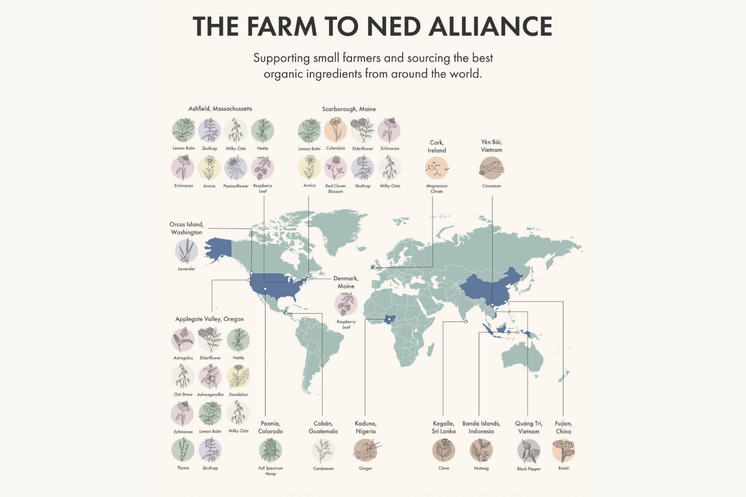WHAT IS AGROECOLOGY?
Agroecology is a sustainable farming approach that works with natural processes. It's important because it promotes healthier food and natural remedy production, conserves resources, and supports environmental and community wellbeing, benefiting both farmers and you!
Farm to Ned Alliance: Agroecology 101
Our current food systems prioritize efficiency and consistency. As the population grows, these factors can be important, but it comes with long-term risks. We are diminishing the soil biodiversity, lowering the nutrients in our food, and increasing infectious diseases. While climate change can be a hot topic and animal extinction is a part of life, current statistics show it is happening “1,000 to 10,000 times faster because of human activity” (Cho, 2019). Critics of more natural farming practices also note that it will use more land and might lead to higher rates of deforestation (1). There can be a way to meet in the middle, by restoring the farming practices of our Indigenous ancestors using agroecology.
Agroecology is the scientific application of combining the farming practices of Indigenous cultures with our traditional food systems (1). It highlights soil biodiversity, supports food security, focuses on sustainability, and uses productive approaches. Increasing our education about farming practices helps consumers support farmers who use principles of agroecology. By shopping at farmers markets or with Community Supported Agriculture, you are supporting the local economy and voting with your dollar. In this way, you can help make a difference in restoring the quality of soil, food, and human health!
At Ned, we partner with farmers who use these practices, and we have actually been able to lower the cost of our products by cutting out the middlemen and forming a direct relationship with small farmers. It also enhances the phytochemicals in our blends, making them stronger and more effective than other brands.
Daily Blend
30mL (1oz)
Simplify your daily ritual with Daily Blend, a single all-natural primer for better health and wellness. Slow crafted from the world’s purest USDA certified organic hemp, Daily Blend helps you build your health on a strong foundation by bringing your body back into balance (think of it as restoring your body to its optimal factory settings!) and providing functional support for sleep, stress, and pain + inflammation.
60-day Stress Free Guarantee
Simply place your order. Your 60-day trial begins from the day your order is delivered.
Start using your Ned product. Our Customer Happiness Team is here to give you all the guidance you need.
If you want to break things off, no hard feelings. Contact our Customer Happiness Team and they’ll help you out. Simple.
**Valid for one product at a time - bundles not eligible
Sleep Blend
Sleep deeper, longer and wake up refreshed with Sleep Blend — the natural path to deeper sleep. This organically made tincture tincture blends CBN — a powerful cannabinoid that promotes sleep, full spectrum hemp from the purest single source hemp flower extract and organic botanicals used in traditional medicine.
60-day Stress Free Guarantee
Simply place your order. Your 60-day trial begins from the day your order is delivered.
Start using your Ned product. Our Customer Happiness Team is here to give you all the guidance you need.
If you want to break things off, no hard feelings. Contact our Customer Happiness Team and they’ll help you out. Simple.
**Valid for one product at a time - bundles not eligible
De-Stress Blend
De-Stress Blend is a natural path to stilling your waters and getting back to easier times. This blend is dominant in CBG – often referred to as the mother of all cannabinoids - and CBD, both extracted from the world’s purest full spectrum hemp and features a botanical infusion of ashwagandha, cardamom and cinnamon.
60-day Stress Free Guarantee
Simply place your order. Your 60-day trial begins from the day your order is delivered.
Start using your Ned product. Our Customer Happiness Team is here to give you all the guidance you need.
If you want to break things off, no hard feelings. Contact our Customer Happiness Team and they’ll help you out. Simple.
**Valid for one product at a time - bundles not eligible
The 7 characteristics of Agroecology (1):
1. Crop rotation
Crop rotation is when different crops are planted in the same spots during different seasons. This helps add a wide variety of nutrients to the soil all season long.
2. Cover crops
Farmers intentionally plant crops, such as clover, to cover the soil without plans of harvesting. This helps add biodiversity to the soil, prevents weeds and pests, and keeps the soil moist to prevent water waste.
3. Polyculture
Polyculture is the practice of growing many varieties of plants and raising a variety of animals in the same farming habitat. This is an efficient way to use space and maximize production.
4. Green Manure
Green manure is made from the cover crops, which are churned into soil to improve the nitrogen levels, nutrients, and prevent weeds.
5. Minimal Tillage
This is a farming practice which has become more common. By keeping the soil covered and undisturbed, the roots can grow and form a healthy underground ecosystem.
6. Natural Irrigation
By using the practices above, the soil will have a better capacity to hold water and prevent water waste.
7. Crop-Livestock Integration
Farms who integrate a variety of crops and livestock together reduce the need for fertilizers, and the natural grazing habits of animals tends to the plants.
References
- Carlile, T., Garnett, T. (2021). What is agroecology? The Table. https://tabledebates.org/building-blocks/agroecology
- Jeanneret, P., Aviron, S., Alignier, A., Lavigne, C., Helfenstein, J., Herzog, F., Kay, S., & Petit, S. (2021). Agroecology landscapes. Landscape ecology, 36(8), 2235–2257. https://doi.org/10.1007/s10980-021-01248-0
- Cho, R. (2019). Why Endangered Species Matter. State of the Planet. https://news.climate.columbia.edu/2019/03/26/endangered-species-matter/











